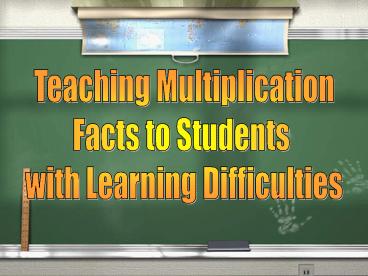Teaching Multiplication PowerPoint PPT Presentation
1 / 25
Title: Teaching Multiplication
1
Teaching Multiplication Facts to Students with
Learning Difficulties
2
A Graduate Research Project
By Theresa L. Lemus Santos
3
The Problem
4
The overarching problem is that students with
disabilities have difficulty learning
multiplication facts.
Why??
5
Existing Research
- Smith and Smith, 2006 - retention and
comprehension - Masoura, 2006 - working memory
- Burns, 2005 - Processing
- Stading and Williams, 1996 - use counting
6
How do students with disabilities learn best?
Williams and Collins, 1994
- 3 modalities
- 3 stages
7
The Project
8
Using the Research of
- Williams and Collins, 1994
- Brookhart, Andolina, Zuza, and Furman, 2004 -
Self assessment - To design a program to teach multiplication facts
9
The Concrete Stage
In this stage, multiplication facts revolve
around a physical model of a key.
FOR EXAMPLE 3 x 6 would be
10
18
11
The Semi-Concrete Stage
Varies from the concrete stage
12
Symbolic Stage
- Presents the facts in their traditional form.
3 x 6 18
13
Methodology Used
14
The Groups
- Students with Disabilities
- Experimental and Control Group
- Consist of 7 students each
- General Education Students
- Experimental and Control Group
- Consist of 20 and 21 students respectively
15
The Instruction
- Two 30-minute sessions per week
- Experimental Group The program
- Control Group Traditional flash cards
- The Hypothesis
- Pre-test/Post-test
- Fact quizzes and student self-assessment
16
Findings
17
Table 1. Results of t-Test for Independent Means
Students with Disabilities
M SD t p
Experimental group 47.86 1.88 1.73 0.05
Control group 41.29 3.30
18
Table 1. Results of t-Test for Independent Means
General Education Students
M SD t p
Experimental group 49.85 .10 3.29 0.0011
Control group 43.57 1.60
19
Conclusions
20
The Results
- Pre-test scores low
- Means of the Posttests
- T-test results
21
Implications
For Education
22
- Use of multi-sensory approach
- Concrete to Symbolic
- Student Self-assessment
23
References
24
- Brookhart, S. M., Andolina, M., Zuza, M.,
Furman, R. (2004). Minute math An action
research study of student self-assessment.
Educational Studies in Mathematics, 57, 213-227.
- Burns, M. (2005). Using incremental rehearsal to
increase fluency of single-digit multiplication
facts with children identified as learning
disabled in mathematics computation. Education
and Treatment of Children, 28, 237-249. - Campbell, J. I. D. (1997). On the relation
between skilled performance of simple division
and multiplication. Journal of Experimental
Psychology Learning, Memory, and Cognition, 23,
1140-1159. - Gelzheiser, L. M., Solar, R. A., Shepherd, M. J.,
Wozniak, R. H. (1983). Teaching learning
disabled children to memorize A rationale for
plans and practice. Journal of Learning
Disabilities, 16 421-425. - Greene, G. (1999). Mnemonic multiplication fact
instruction for students with learning
disabilities. Learning Disabilities Research
Practice, 14(3), 141-148. - Kaufmann, L., Lochy, A., Drexler, A., Semenza,
C. (2004). Deficient arithmetic fact
retrieval-storage or access problem? A case
study. Neuropsychologia, 42, 482-496. - Kroesbergen, E. H., Van Luit, J. E. H. (2002).
Teaching multiplication to low math performers
Guided versus structured instruction.
Instructional Science, 30, 361-378. - Lee, D. L., Stansbery, S., Kubina, R., Jr.,
Wannarka, R. (2005). Explicit instruction with or
without high-p sequences Which is more effective
to teach multiplication facts? Journal of
Behavioral Education, 14(4), 267-281. - Masoura, E. V. (2006). Establishing the link
between working memory function and learning
disabilities. Learning Disabilities A
Contemporary Journal, 4(2), 29-42. - Mauro, D. G., LeFevre, J., Morris, J. (2003).
Effects of problem format on division and
multiplication performance Division facts are
mediated via multiplication-based
representations. Journal of Experimental
Psychology Learning, Memory, and Cognition, 29,
163-170.
25
- Robinson, K. M., Arbuthnott, K. D., Gibbons, K.
A. (2002). Adults representation of division
facts A consequence of learning history?
Canadian Journal of Experimental Psychology, 56,
302-309. - Smith, S. Z., Smith M. E. (2006). Assessing
elementary understanding of multiplication
concepts. School Science Mathematics, 106(3),
140-149. - Stading, M., Williams, R. L. (1996). Effects of
a copy, cover, and compare procedure on
multiplication facts mastery with a third grade
girl with learning disabilities in a home
setting. Education and Treatment of Children,
19(4), 425-434. - Steel, S., Funnell, E. (2001). Learning
multiplication facts A study of children taught
by discovery methods in England. Journal of
Experimental Child Psychology, 79(1), 37-55. - Williams, D. M., Collins, B.C. (1994). Teaching
multiplication facts to students with learning
disabilities Teacher-selected versus
student-selected material prompts within the
delay procedure. Journal of Learning
Disabilities, 27, 589-597. - Wood, D. K., Frank, A. R. (2000). Using
memory-enhancing strategies to learn
multiplication facts. Teaching Exceptional
Children, 32(5), 78-82. - Wood, D. K., Frank, A. R., Wacker D. P. (1998).
Teaching multiplication facts to students with
learning disabilities. Journal of Applied
Behavior Analysis, 31, 323-338.

